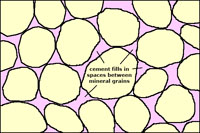6.11: Sediments Classification Based On Grain Size
- Page ID
- 9988
Sediments Classification Based On Grain Size
Sediments are solid fragments of inorganic or organic material that come from the weathering of rock and soil erosion, and are carried and deposited by wind, water, or ice. They range in size from large blocks to microscopic particles. Figure 6.39 shows the technical definition of sediment particles. However, general usage is as follows ranging from largest to smallest: boulders, cobbles, gravel, sand, silt, and clays.
Sediments form from the disintegration of rocks. They are transported, mostly by water, and in the process the fragments are abraded, with sharp edges worn down and the overall shape of particles increasing in roundness. Sediments derived from erosion on land are mostly lithogenous sediments.

Figure 6.39. Classification of sediments by size of clasts (rock fragments)
Clastic sediments and sedimentary rocks
The word clastic is also commonly used to describe sediments or sedimentary rocks composed of fragments (or detritus) derived from older rocks. The word clast means rock fragment; the word is derived from the Greek word klastos which means broken. Gravel, sand, and silt are examples of clastic sediments. Lithogenous sediments (described above) are mostly clastic sediments. A classification of clastic sediments and sedimentary rocks is illustrated in Figure 6.39 and with details discussed below.
How do sediments become sedimentary rocks?
Sediments can become lithified into sedimentary rocks once they've been deposited in a stable setting where burial, compaction, and cementation can take place. The processes, collectively called lithification (or diagenesis) typically takes place slowly over time but rates depend on many factors including the chemistry of the sediments and groundwater passing through the sediment, and how quickly or deeply burial takes place. Deposits of unconsolidated sediments typically have high porosity—pores are open spaces between grains filled with gas or fluids (water or in some cases, petroleum). Compaction is the process of gravitation consolidation of sediments, decreasing the volume of pore space between particles of sediment and increasing hardness. Cementation involves processes that harden sediments through the precipitation of minerals in pore spaces between grains of rock and mineral fragments, binding them together (Figure 6.40). Common minerals that form cement include quartz, calcite, limonite, hematite, and clays. The cementing minerals are slowly deposited between grains by groundwater.



